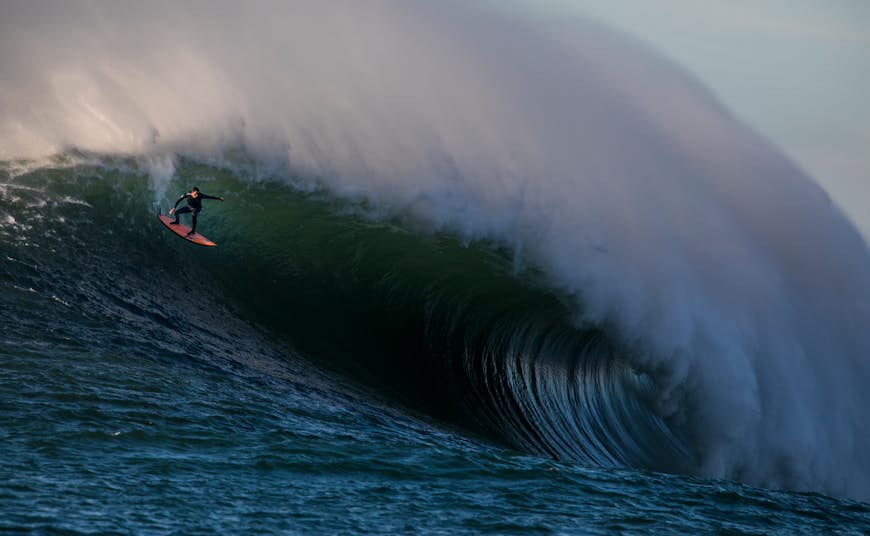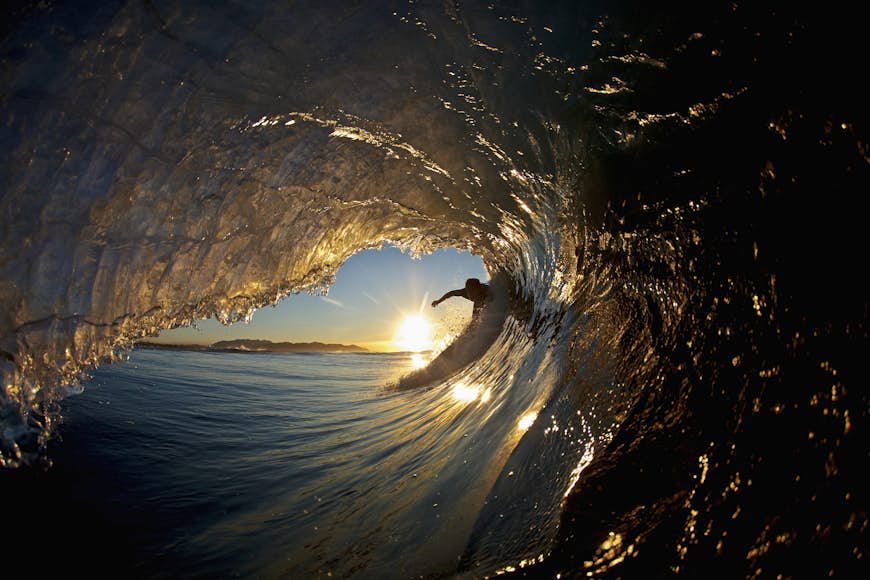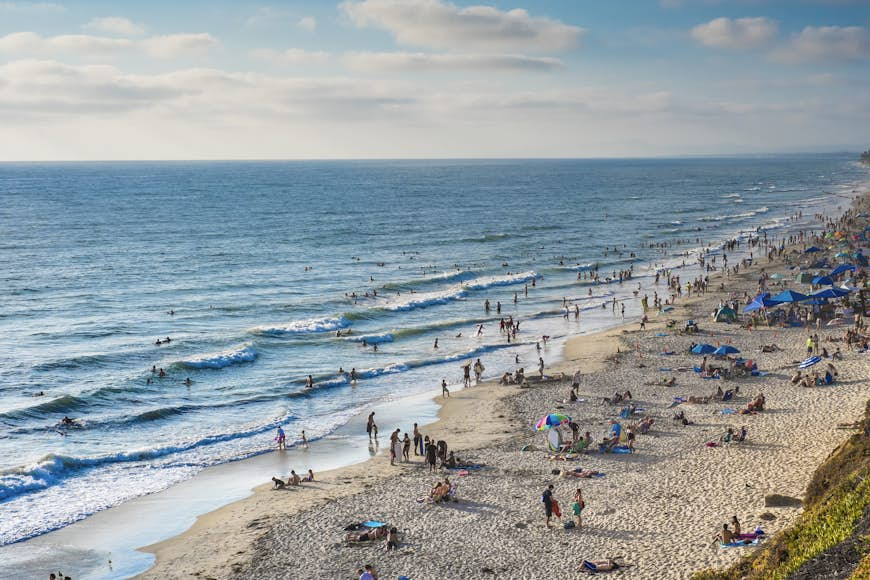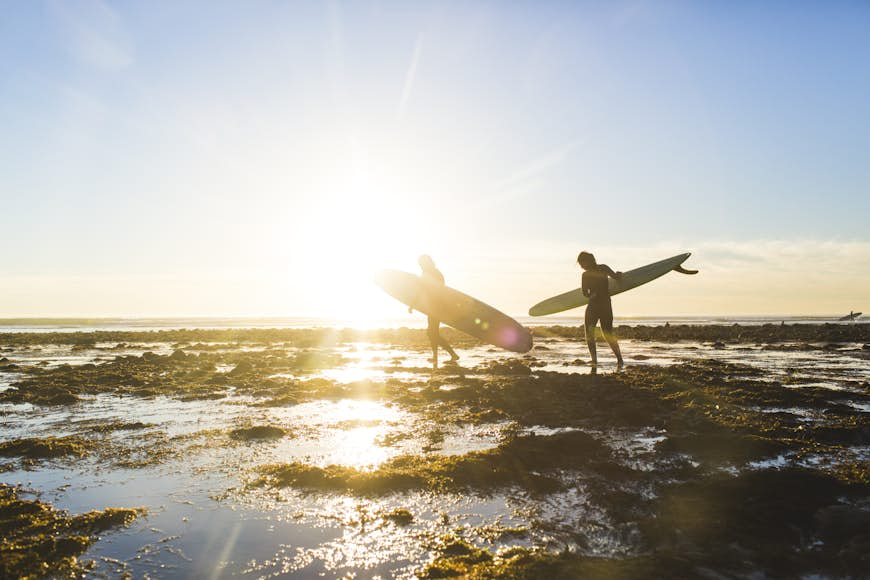Hawaii might lay claim to the first waves ever ridden, but surf culture was born in California. Whether it’s the salt-washed hair of the Lords of Dogtown, the tunes of the Beach Boys or the legendary Endless Summer crew, there are countless examples of how California is intertwined with the world of wave chasing. It’s got the goods to back it up, too.
An 840-mile coastline stretches the length of the Golden State, starting with the sun-scorched deserts on the Mexican border all the way to the swaying redwoods of the Sonoma Coast. In this vast stretch of coast are some of the planet’s most iconic breaks, offering everything from monstrous waves to mellow longboard breakers that channel the power of the Pacific.
Surfing etiquette in California
The same rules of surf apply whether you’re roller-skating down busy boardwalks or practicing on a minimal board: You must give way to the surfer that’s closest to the peak of the wave; never drop in on waves that someone else is already surfing; and always remain in control of your board.
There’s a little more to think about when scouring the West Coast, though. First and foremost, surfers should choose spots that match their skill level. Some of California’s most powerful waves can look deceptively easy. Trestles is a good example. Loads of surfers come here on a pilgrimage, but it’s harder than it looks, with a shifty peak and barreling sections that can be tricky to make.
Next to consider are the certain spots where localism – the protective nature of local surfers – is off the scale. Lunada Bay in Los Angeles county is perhaps the best-known example of this, but it happens in many other locations as well, especially the busy ones. The best advice is to steer clear of spots known for localism and do what you can to avoid confrontation (remaining calm and being polite is a good start).
The best time to surf in California
The Golden State really is the land of endless surf. Different seasons work at different points along the coast.
Generally speaking, the fall and the winter are the top times to surf. SoCal (from Los Angeles down to San Diego) is blessed with Santa Ana winds, but those are offshore during fall and winter, so big swell pulses come in from the northwest Pacific to fire up Trestles, Blacks and others.
This time of year is also perfect for spots like Santa Cruz and Mavericks, where wrap-around swells bring in powerful waves.
But don’t worry if you’re looking to surf in the summer: spots with south-running swells are great this season. Malibu is a prime example. It’s loaded with south-facing points that do wonders on smaller days, when the locals crack out the longboards for cruisier sessions.
Here are some of the Golden State’s top places to surf.
Trestles: A trio of legendary breaks
All hail Trestles. If there were a worldwide surf spot beauty pageant, Trestles would be California’s entry. Considered one of the finest breaks anywhere, it’s got World Surf League pedigree and even hosted the one and only Duke Kahanamoku back in the 1940s.
There are three distinct sections: Uppers, Lowers and Middles. Lowers is the money wave. Technically a point break, it actually forms up like an A-frame to give rides in both directions. But, it’s the rights that wow, with steep walls of peeling water that feel more like the product of an artificial wave pool than the Pacific Ocean.
Trestles is hallowed ground in the world of surfing. Many a pro and legend has cut their teeth dipping under the railway line and riding beneath the sinewy cliffs of San Onofre State Beach. Unsurprisingly, it’s “protected territory,” patrolled by vocal San Clemente crews that don’t take too kindly to visitors who are out of their depth.
Getting to Trestles: Come off Interstate 5 at the San Onofre State Park, about 50 minutes north of downtown San Diego.
Blacks Beach: San Diego’s surf playground
With one foot in the Torrey Pines State Reserve and another in San Diego County, this 2.5-mile-long stretch is a veritable playground for the folk of La Jolla and the University of California San Diego, which has a campus just behind. The area benefits from an offshore canyon that, like in Nazaré, directs groundswells into a series of neat peaks when there’s any element of west swell in the forecast.
It’s the A-frame wave at the center of Blacks that draws the drool of surfers as they zigzag down the thigh-burning pathways. The wave can hold its huge size and bowls beautifully in glassy green rooms that spin overhead in both directions. Goofy riders might prefer South Peak, a hollow left that loves long periods (time between waves).
Blacks is no secret. Cohorts of students fresh from the lecture halls meet burly SoCal veterans in the lineup, sometimes to less-than-savory effect. Respect the credentials and everything should go smoothly, but don’t expect to be alone.
Getting to Blacks Beach: This requires some patience. You can use the Saigon Trail from the La Jolla Farms Road to get to South Peak or take the Torrey Pines Gliderport Trail that goes from the main parking lot. Both are just over 10 minutes off I-5 north of San Diego.
Mavericks: For the daredevils
Many a surf legend has been made and broken at Mavericks since local charger Jeff Clark first conquered the spot back in 1975. Before that, it was written off as way too dangerous. The truth is, to most, it still is. Routinely peaking at over 25ft in hard winter swells, this is the XXL monster of Northern California – a spot that only a couple of pros will ever ride.
The prowess is down to a submerged rock reef that ramps away from the coast with deep channels cut on either side. This sucks all the power into a single wedge of water that roars into life beneath the cliffs of Pillar Point just south of San Francisco. There’s a left and a right, but the former requires more guts than a Cannery Row factory because it’s fast, hollow and unpredictable.
Getting to Mavericks: Mavericks makes its home in Half Moon Bay. Access is from the Pillar Point Harbor, about a 30-minute drive south on the Cabrillo Highway from San Franciso.

Malibu: Arguably the home of SoCal surf culture
Celebrity-led sushi kitchens, health smoothie shops, and swanky villas might be the name of the game today, but Malibu has been a surfer’s playground since the 1920s. By the ’50s, it became the stomping ground of the crew of Miki Dora, the notorious conman-come-surf pioneer. After Gidget – a semi-biographical pastiche to Malibu surf culture – hit Hollywood screens in 1959, the area’s destiny was firmly set.
Today, there’s little chance you’ll find an empty wave anywhere in the 27-mile-stretch of coast that Malibu calls its own. Famous spots include the trio of cruisy right-hander points at Surfrider Beach and the frothy winter sets at Zuma Beach (the one-time filming location for Baywatch, no less). Season-wise, Malibu is a bit of an anomaly in California. The coast bends to gaze south here, meaning summer swells tend to be better.
Getting to Malibu: Access to Malibu is now a cinch – the Pacific Coast Highway connects to most beaches, with paid parking all the way along. Just drive north from LA.
Rincon: Perfect, peeling point breaks
Up there with J-Bay and Burleigh Heads among the finest point breaks on the planet, Rincon is a little bevel on the California coast between Ventura and Santa Barbara. The bevel is just about enough to cause the winter northwest swells to wrap around and peel into the bay in sculpted sets of right-hand waves that are good enough to host competitions.
On the best days, the whole of Rincon can link together, but it’s helpful to separate the wave into three parts. The first is Indicators, a fast and powerful right that’s at the most exposed part of the point. Then you get the barrels of Rivermouth, followed by the semi-hollow shoulders of The Cove, the most turn-inviting section that can take you all the way to the beach.
Getting to Rincon: Rincon Point is on the county line between Santa Barbara and Ventura. It’s accessible on the 101 just south of Carpinteria.

Santa Cruz: The birthplace of surfing in the Golden State
The year is 1885. Surfing and California are lovers yet to meet. In Santa Cruz, three Hawaiian princes take a break from their studies and mosey down to the mouth of the San Lorenzo River with wood-carved plank boards in hand. What they do on the waves will change the fortunes of the town and the state forever.
Nearly 50 years later, the legendary Duke Kahanamoku would also drop by, but, by that time, surfing was firmly implanted in the DNA of Santa Cruz locals. Today, it’s a deserving World Surfing Reserve, with 10 named breaks that ooze quality.
Steamer Lane is the star of the show in Santa Cruz. You’ll find it tucked into the western end of Cowell Beach just up from the Santa Cruz Wharf, splitting into sections like barreling Middle Peak and the steep walls of Indicators. Both are always busy, but a rite of passage for surfers that are at an intermediate level and higher.
Getting to Santa Cruz: Take Highway 17 south from San Jose or the famous Highway 1 south out of San Francisco.
Swami’s: Cruisy rides for longboarders and shortboarders
Eulogized by the Beach Boys and made famous as the stomping ground of pros like Rob Machado, whose sunflower-shock hair you can still sometimes spy in the lineup, Swami’s is a rare right-hand reef break in the San Diego North County.
Low tide works best here when there’s a westerly direction in the swell. The wave is a shapely peeler that can run for more than 100 meters back to the sand, though the bicep-burning paddle out means that most surfers don’t go all the way, at least not until the end of the session.
Swami’s is named for the Self-Realization Fellowship Encinitas Retreat, a meditation garden and ashram just up on the clifftops above. It’s sandwiched in by a whole host of other surf spots, which together make the town of Encinitas such a draw. Beginners can check out the peaks of Moonlight Beach to the north. Longboarders can hit up the Cardiff Reef to the south.
Getting to Swami’s: Make for the town of Encinitas. It’s about a 30-minute drive up I-5 from San Diego. Swami’s is on the south side of town. There’s parking on 1st Street.

The Wedge: The unruly beast of Cali surfing
Last, but most certainly not least, comes this infamous jetty break at the tip of Balboa in Newport Beach. Water sloshes in all directions here when the swells are high, bouncing back off the breakwater and churning against the steep sand to create a swirling and unpredictable washing machine effect.
It’s more of a bucking bronco than a wave, but that’s the challenge. Those gutsy enough to do battle with The Wedge have to deal with a steep drop into a wild wall of water that doubles up, splits, falls away and reforms without any clear pattern. You might get through to the other side, but it’s rare. Usually, you’ll be tossed out like a ragdoll, which is why it’s only for those who really know what they’re doing. Broken boards and broken bones are common.
Getting to The Wedge: Set your GPS for “E Ocean Boulevard” at the tip of the Balboa Peninsula. It takes just over 40 minutes to get there from Downtown LA. Parking is super limited, so plan to arrive early.
